Day 1: Arrival at Denver International Airport (DEN) departing southwestward once everyone has arrived. As we draw near to Gunnison, the landscape changes and we’ll savor an afternoon of birding amid the region’s arid landscape.
During dinner, our first as a group, we’ll make introductions, discuss tour details so participants know what to expect during the tour (pace, conditions, daily routine, etc.), illustrate our planned route and hand out checklists. Night Gunnison.
Day 2: Our first pre-dawn departure, this time to enter blinds for viewing the first of our lekking chickens—Gunnison Sage-Grouse. Our blind is operated by Sisk-a-Dee, a conservation group dedicated to the conservation of the Gunnison Sage-Grouse. While the birds are a bit distant, spotting scopes allow us to witness their action packed displays without affecting the birds.
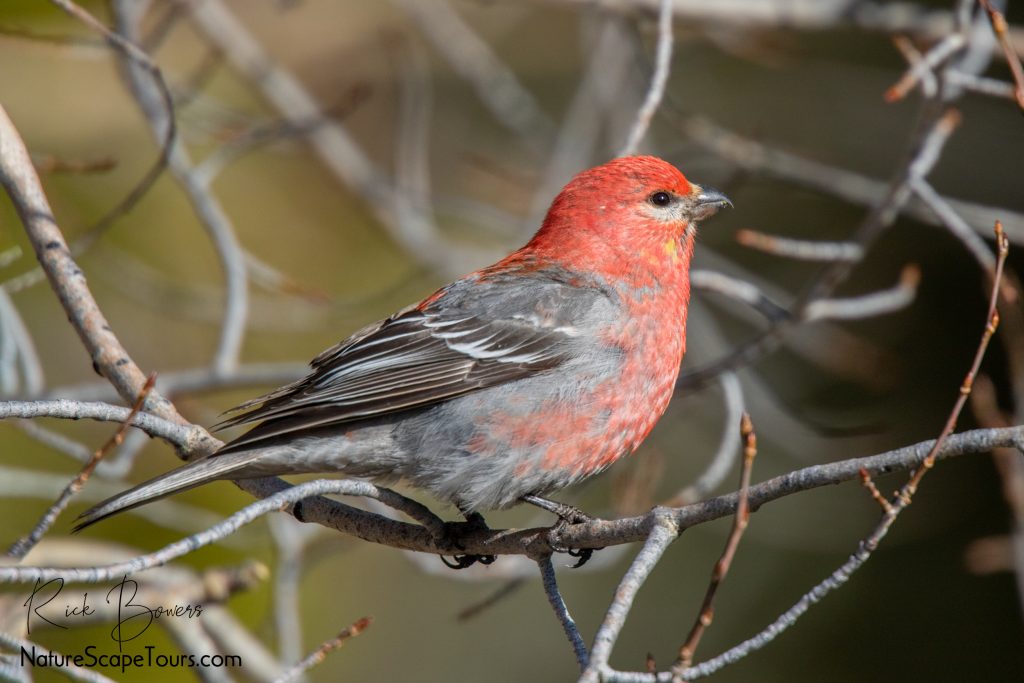
Male Pine Grosbeak on the 2018 Colorado Chicken Run.
Once the birds have left their lek, we’ll depart for breakfast and begin our journey eastward. Along the way we’ll stop at Monarch Pass to look for montane birds like American Three-toed Woodpecker, Clark’s Nutcracker, Pine Grosbeak and Red Crossbill. Night Pueblo.
Day 3: Sunrise will find us searching for arid country birds approaching the northernmost extent of their range—Scaled Quail, Greater Roadrunner, Curve-billed Thrasher, Rufous-crowned Sparrow and Canyon Towhee—we’re likely to find more widespread species like Burrowing Owl and Say’s Phoebe. The Arkansas River Valley’s scenic cliffs harbor thick areas of Junipers that often produce Wintering Townsend’s Solitaires, Juniper Titmouse, Bushtit, Woodhouse’s Scrub-Jay and Spotted Towhee.
After returning to our hotel for breakfast and luggage, we’ll point our compass east toward the short grass prairies of the Comanche & Cimarron National Grasslands. As we travel parts of the Historic Santa Fe Trail, Prairie Falcon, Swainson’s and Ferruginous Hawks may be found.
As we travel this extreme eastern corner of Colorado, we might encounter Long-billed Curlew, Chihuahuan Raven, migrant flocks of Lark Buntings, sparrows and longspurs. We’ll cross into Kansas in the late afternoon, hopefully with time for a brief birding break by visiting a nearby Lesser Prairie Chicken lek. Night Dodge City.
Day 4: Another pre-dawn start in order to arrive at a chicken lek in the darkness. Sitting on the pre-sunrise prairie listening to Lesser Prairie Chickens is an experience like no other. Waiting for enough light so you might put pictures with the decidedly odd sounds emanating from the lek can be difficult for the inpatient. Luckily it’s worth waiting for…and the sun rises quickly on the prairie.

Lesser Prairie-Chicken displaying.
We’ll enjoy the chickens performing their Spring rituals, departing only after we’ve had our fill. After breakfast, we’ll travel back roads looking for migrant sparrows along brushy field margins. Vesper, Lark, Cassin’s, Grasshopper and Brewer’s Sparrows along with Lark Bunting are the usual suspects. Searching the grasslands may turn up nesting birds such as Ferruginous Hawk, Burrowing Owl, Long-billed Curlew, Loggerhead Shrike or Chihuahuan Raven.
We must soon turn northwestward as we begin our long trek to Colorado’s portion of the Nebraska Sandhills and the little town of Wray. Our trip is broken by stops to look for birds and chances to walk around. There are several migrant traps and reservoirs that demand checking during migration. These will be our best chance to add birds with a decidedly eastern flavor to our list. Red-bellied Woodpecker, Blue Jay, the eastern form of White-breasted Nuthatch, Eastern Bluebird and Northern Cardinal are likely additions.
Before supper we’ll visit a private ranch to view one of many leks located on the property. We’ll be able to view several Greater Prairie-Chickens in a more subdued evening performance. Night Wray.
Day 5: Following our now well established pattern of rising before sunrise, we’ll return to our Greater Prairie-Chicken lek to enjoy the manic sunrise activities of these prairie grouse. One final intimate experience with these vanishing symbols of America’s Great Plains.
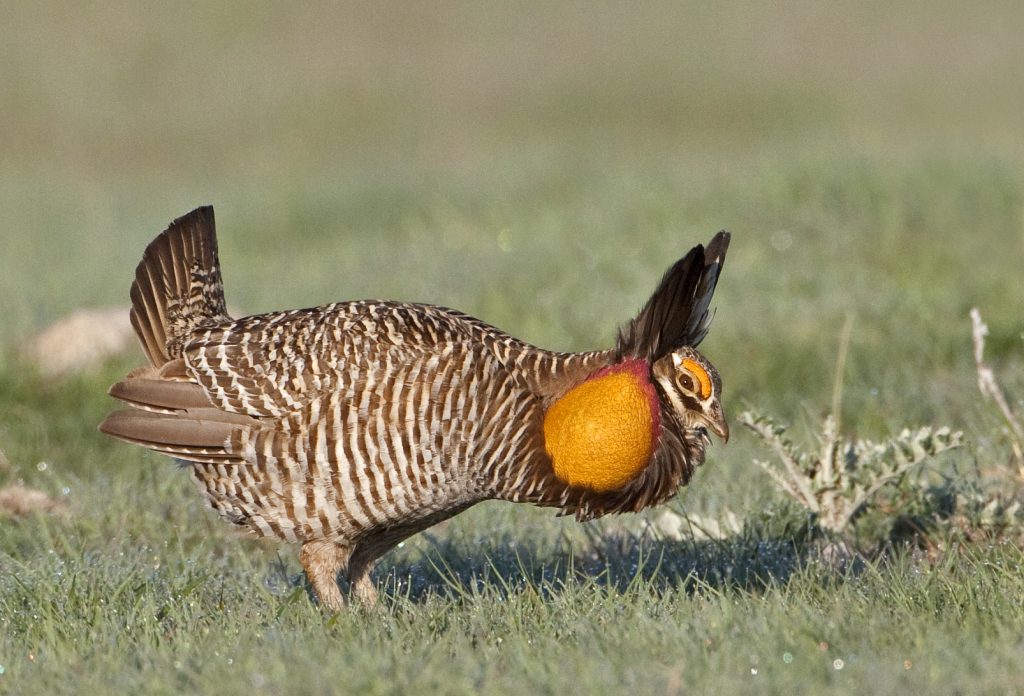
Greater Prairie-Chicken male displaying. Photo by Kim & Cindy Risen.
After breakfast, our travels take us north and west crossing the Pawnee National Grasslands. Habitats change a bit each mile and we’ll be in search of Mountain Plover, Golden Eagle, Prairie Falcon, Burrowing Owl, McCown’s and Chestnut-collared Longspurs and a host of possible migrants. New to this year’s itinerary is our stay in Greeley. This enables us to have a full afternoon/evening of prairie birding. Even better, we’ll be able to enjoy dawn on the prairies, witness the rising crescendo of bird song and chase down any birds we might be missing. Night Greeley.
Day 6: With over 190,000 acres, the Pawnee National Grasslands are a prairie stronghold within sight of the Rocky Mountains. Created as a result of “Dust Bowl” era circumstances, the grasslands boast a rich history within its rolling plains. We’re hoping for migrating sparrows, longspurs and other grassland specialties while we search for newly arrived Mountain Plover, Ferruginous & Swainson’s Hawks, Burrowing Owl, Prairie Falcon and Chestnut-collared and McCowen’s Longspurs.
Late afternoon finds us climbing foothills to reach the charming North Park village of Walden. As we ascend, our surroundings quickly change as do our birds. After a quick stop to view American Dipper we’ll continue upward into the mountains. These transitional foothills enroute to montane forest hold Red-naped and Williamson’s Sapsuckers, three species of nuthatches and Mountain and Western Bluebirds, among others. Hopefully we’ll arrive in at our hotel in time for a short drive to view a collection of bird feeders that have been good for rosy-finches in past years. An after dark search for Boreal Owl and Northern Pygmy-Owl is possible. Night Walden.
Day 7: Only the pre-dawn darkness greets us as we arrive atop a sage covered hilltop that Greater Sage-Grouse have declared perfect for their lek. Weather cooperating, we should be treated to an amazing show by these large, somewhat odd looking birds. While their displays aren’t as manic as the closely related Gunnison Sage-Grouse, they remain a riveting spectacle.
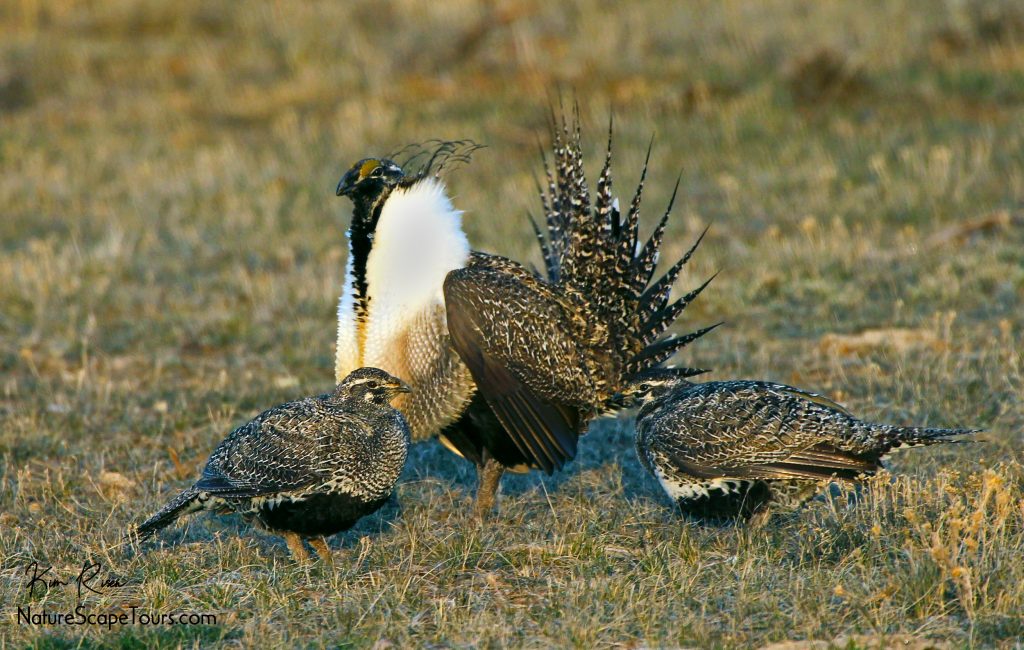
Greater Sage-Grouse Male and Females.
After breakfast we’ll tour North Park visiting several lakes & water impoundments that my be bustling with a surge of newly arrived Spring migrants, wet grasslands and sage covered hillsides that may hold their own migrants. The journey around North Park is quite scenic. Along the way, we should be able to locate Sage Thrasher, Townsend’s Solitaire and Mountain Bluebird with other possibilities including Dusky Grouse, Clark’s Nutcracker, Evening Grosbeak, Red Crossbill and Pine Grosbeak. This part of North Park is also the best area in Colorado to view Moose. With luck we may see several of these decidedly odd creatures before our day ends.
We may visit Loveland Pass in pursuit of White-tailed Ptarmigan, still attired in angelic white even this late in the Spring. After lunch, we’ll search for any Barrow’s Goldeneye that may have delayed their departure from the area and an assortment of newly arriving waterfowl. With luck we may see Cinnamon Teal performing their first courtships of the Spring. There is great potential for migrants and mountain birds before returning to North Park. Another after dark search for Boreal Owl and Northern Pygmy-Owl is possible if necessary. Night Walden.

White-tailed Ptarmigan at Loveland Pass, Colorado on the 2018 Colorado Chicken Run!
Day 8: As the sun brightens the forest around Walden, we’ll visit nearby feeders hoping for Brown-capped, Gray-crowned and Black Rosy Finches. Many resident birds will be in full song with Pine Grosbeak, Mountain Chickadee, Pygmy Nuthatch and Cassin’s Finch leading the way.
The balance of our day has several options, depending upon what birds we’ve seen and what kind of weather the region has enjoyed this early Spring. Lunch may be a picnic atop a windswept pass or at the head of a sage brush covered valley. What’s promised is fun birding and a good time! Night Craig.
Day 9: Pre-dawn departure toward Hayden whose hills and valleys harbor Dusky Grouse, Greater Sage-Grouse and Sharp-tailed Grouse. We’ll begin by searching traditional areas for Dusky Grouse before visiting a nearby lek of Sharp-tailed Grouse. Much like Greater Sage-Grouse, Sharp-tailed Grouse are frantic, energetic and vocal during their displays—even more so! Everyone witnessing their antics enjoys the show. While it may be hard to leave these charismatic birds, we must soon begin our drive west and south.
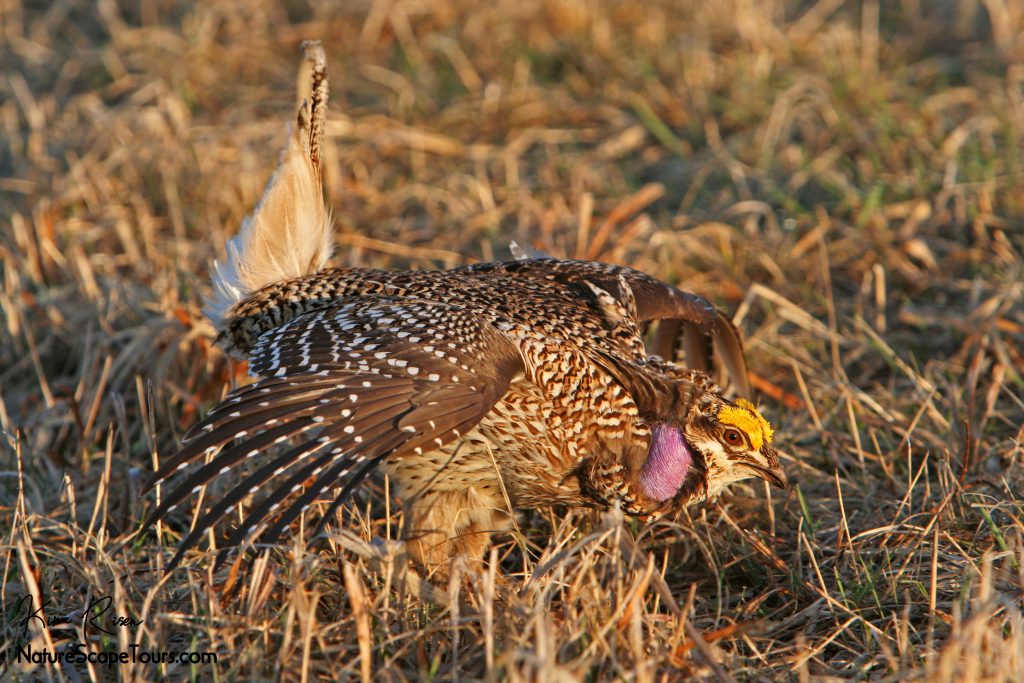
Sharp-tailed Grouse displaying.
Thankfully, changing scenery and birding stops make the drive an enjoyable one and we’ll search wetlands and water areas for Cinnamon Teal and Barrow’s Goldeneye en route to lunch near Rifle. We’ll enter the White River National Forest seeking Pinyon Jay, Bushtit and Juniper Titmouse after we enjoy our lunch.
Our final birding break is a beautiful desert canyon near Cameo where we can search for the elusive Chukar. A short hike through scenic Coal Canyon may produce Black-throated Sparrow, Rock and Canyon Wrens, Gray Flycatcher, Lazuli Bunting or Wild Horses! Night Grand Junction.
Day 10: Our return to the desert canyons near Cameo won’t begin until the eastern skies have begun to brighten. Recent years have shown that a sunrise visit to these beautiful, rocky canyons produce good experiences with oft-difficult-to-find Chukars. (Last year’s tour found nine, several that were able to be photographed!) We’ll travel over the scenic Blue Mesa with a chance to find several montane species of interest—Clark’s Nutcracker, Williamson’s Sapsucker, Pygmy Nuthatch among others. As we travel off of the mesa, we’ll be greeted by fabulous views of the Gunnison Basin and one of Colorado’s most reliable locations for Lewis’s Woodpeckers. We continue to Montrose, Colorado, gateway to Black Canyon of the Gunnison National Park where we’ll have a late afternoon visit to search for Dusky Grouse. Night Montrose.
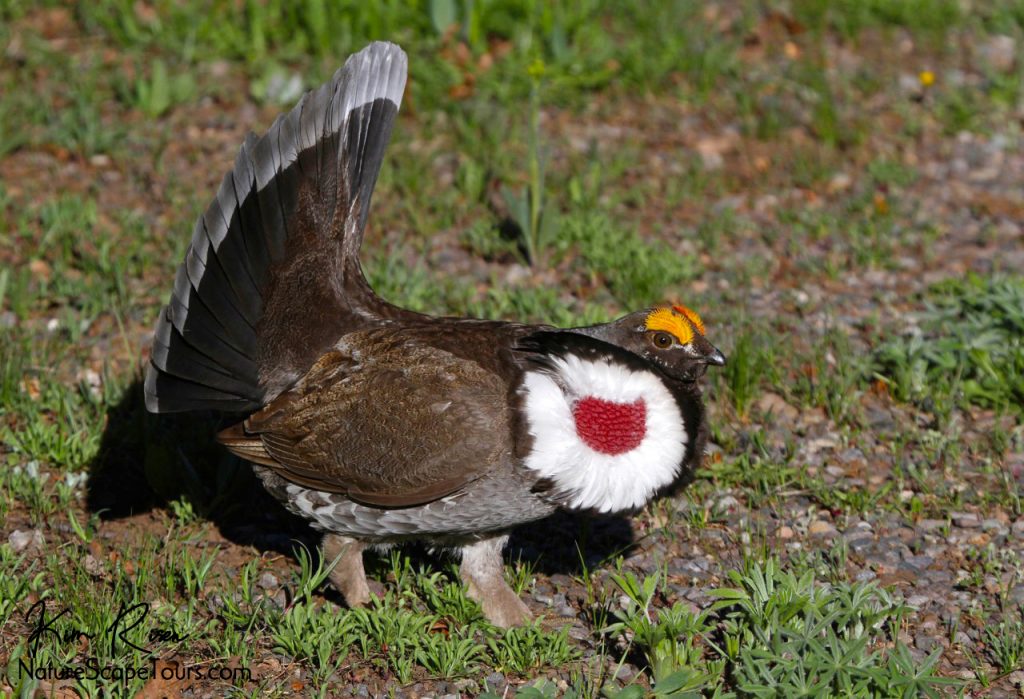
Dusky Grouse male displaying.







